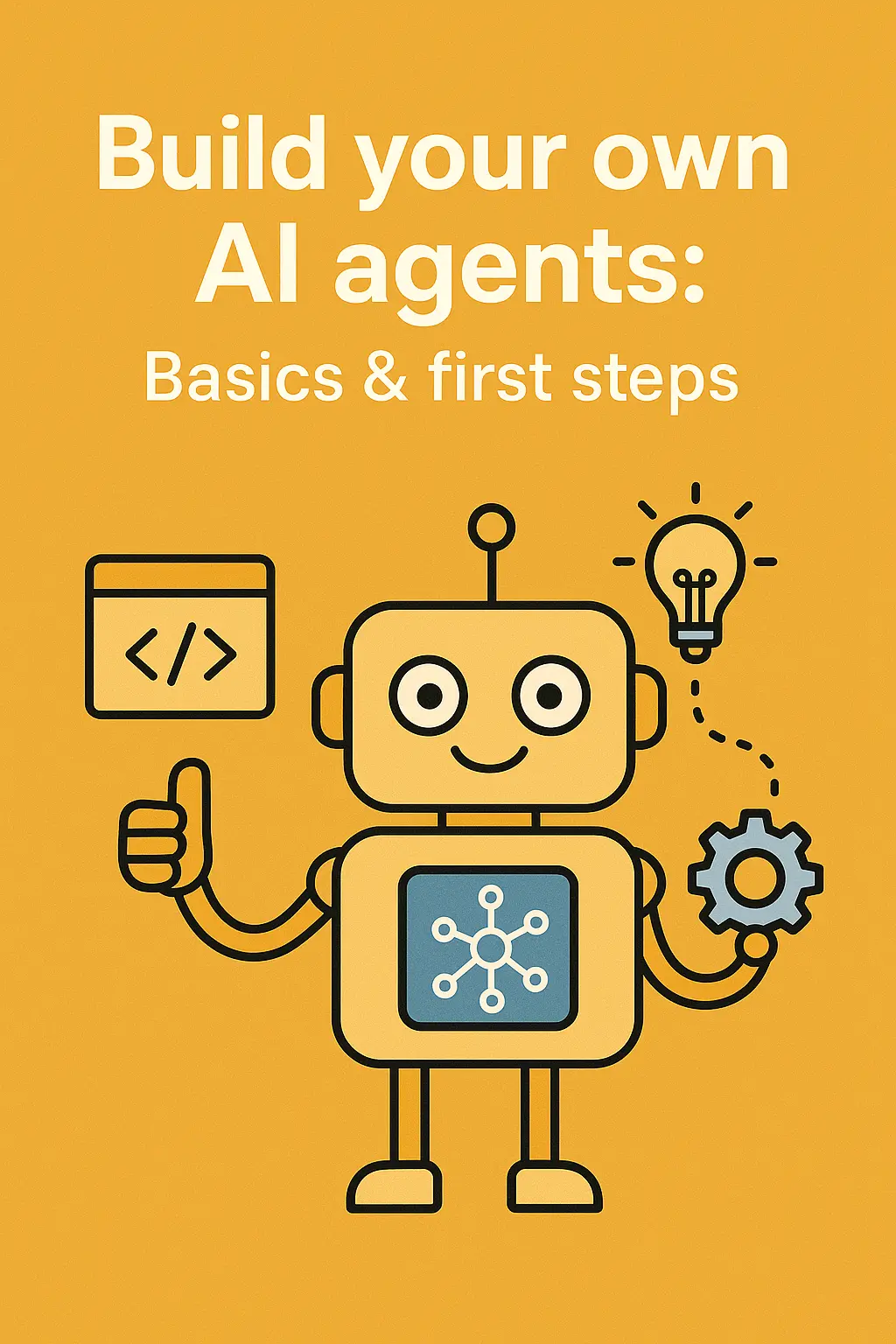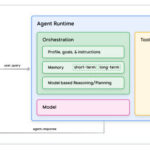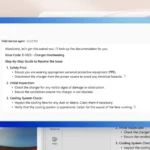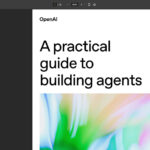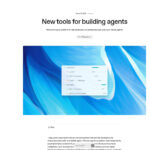AI agents automate not just individual tasks, but entire work processes thanks to their ability to act independently and make strategic decisions. With the right tools and prior knowledge, you can develop powerful agents yourself that will transform your business.
- Perceiving, thinking, deciding and acting are the four core competencies of successful AI agents that set them apart from simple chatbots and make them truly autonomous problem solvers.
- Large Language Models form the central nervous system of your agent, with Claude 3.5 Sonnet offering excellent value for money for beginners at 0.003 US dollars per 1,000 tokens.
- The right development approach depends on your prior knowledge – Botpress enables no-code development in just 2-4 hours of learning time, while Python with LangChain offers maximum flexibility with a higher learning effort.
- Systematic testing is crucial for high quality agents, with at least 50 realistic test calls before your agent goes into production.
- GDPR compliance and transparency must be planned for from the outset – implement data minimization, clear purpose limitation and automatic deletion functions after 30 days.
Build your first AI agent in small, manageable steps and develop it iteratively – this way you will quickly achieve initial success and systematically learn what works best for your specific application scenario.
Imagine your own AI team member working around the clock, taking on routine tasks – and you controlling everything with a few clear instructions. Sounds like science fiction? AI agents are already making this possible. Whether in marketing, customer service or product development: those who build their own AI agents today not only save valuable time, but also set trends instead of following them.
Why shouldn’t you leave this topic to the tech giants? It’s simple: AI agents are not witchcraft, but tools that you can tailor to your everyday business. From automatic content creation to smart ticket distribution in support – you can already automate 70% of standard queries today. The best thing about it: thanks to modern no-code tools and clear step-by-step instructions, really anyone can get started, even without a developer background.
In this article, we’ll show you how to:
- understand the principle behind autonomous agents without getting bogged down in AI jargon,
- find the right tech stack for YOU – whether drag-and-drop or Python scripts,
- get started right away with copy & paste prompts and practical mini FAQs,
- avoid typical pitfalls and recognize when data protection or scaling become an issue.
💡Tip: In the end, it’s not how many complex features you build that counts, but how consistently your agents take real work off your hands and give you room for creative ideas.
Let’s jump straight in – we’ll start where it’s not only technically exciting, but where the ROI is immediately visible for you!
What are AI agents and why should you build them?
AI agents are autonomous software programs that can solve problems independently – far beyond simple chatbots. While conventional bots only react to predefined inputs, modern AI agents can analyze their environment, make decisions and act independently.
The four superhero skills of your AI agent
Every powerful AI agent masters these basic core skills:
- Perceive: Understanding text, files, APIs and user input
- Thinking: Processing and evaluating information with large language models
- Deciding: Choosing between different options for action
- Act: Sending emails, querying databases, using external tools
💡 Tip: Large language models such as GPT or Claude have completely changed the rules of the game. Instead of laboriously programming complex decision trees, you can simply explain to your agent in natural language what it should do.
Degrees of autonomy: from command recipient to self-initiative
AI agents function at different levels of independence:
- Reactive: Only responds to direct user input
- Semi-autonomous: Performs multi-step tasks according to instructions
- Fully autonomous: Recognizes problems and solves them without human intervention
Concrete business applications with measurable ROI
Revolutionizingcustomer support: Automated initial consultation enables up to 70 percent of standard queries to be answered immediately and complex cases to be intelligently forwarded to the right specialist department.
Increase marketing efficiency: Content generation, lead scoring and personalization run around the clock. A medium-sized company saves an average of 15 to 20 hours a week on content creation.
Optimize internal processes: Document analysis, automatic summaries and workflow routing reduce administrative activities by up to 60 percent.
The biggest advantage lies in the combination of speed and consistency – your AI agent works 24/7 without quality fluctuations and learns continuously.
Understanding the architecture of modern AI agents
Modern AI agents function like a digital brain with four specialized areas that work together seamlessly. While classic chatbots only access ready-made answers, real agents can think, plan and act independently.
The “brain”: large language models as a reasoning engine
At the heart of every agent is a large language model, which acts as the central thinking unit. GPT-4 currently costs around 0.03 US dollars per 1,000 input tokens, while Claude 3.5 Sonnet is significantly cheaper at 0.003 US dollars.
Cost comparison 2025:
- OpenAI GPT-4: Premium quality, highest costs
- Anthropic Claude: Best price-performance ratio for complex tasks
- Open source models (Llama 3, Mistral): Free of charge, but own infrastructure required
💡 Tip: Start with Claude 3.5 Sonnet for your first experiments – it offers 90 percent of GPT-4 quality at a third of the cost.
Memory system: Short and long-term memory
Your agent needs two types of memory. The short-term memory stores the current conversation, while the long-term memory retains permanent knowledge about customers or processes.
Vector databases such as Pinecone or Weaviate enable Retrieval Augmented Generation (RAG ). Your agent searches for relevant information from huge knowledge stores and uses it to provide precise answers.
Tools and actions: Developing the ability to act
Function Calling transforms your agent from a mere conversation partner into an active helper. It enables you to send e-mails, create CRM entries or carry out database queries.
Secure tool integration:
- Save API keys in environment variables
- Implement rate limits
- Input validation before each external request
Knowledge Base: Integrate expert knowledge
Your agent becomes a specialist thanks to structured and unstructured data sources. PDF uploads, website crawling and database connections continuously feed its knowledge base.
Legal note: When integrating knowledge, data protection regulations must be observed – especially for personal customer data.
The four components work like a well-coordinated team: the LLM thinks, the memory remembers, the tools act and the knowledge base provides expertise. This modular structure is what makes modern agents so powerful and flexible.
Set up your first development environment
The right development environment determines whether you become successful quickly or get lost in technical details for weeks.
No-code vs. low-code vs. full-code: The right way to get started
Botpress is the perfect start for marketing teams without programming knowledge. You build AI agents using drag-and-drop and can start with real user tests immediately. Costs: From 15 euros per month, learning time: 2 to 4 hours.
LangChain with Python offers maximum flexibility for tech-savvy users. You can customize every aspect of your agent and develop complex multi-agent systems. Costs: API fees only, learning time: 20 to 40 hours.
Copilotkit is aimed at product owners with React knowledge. It enables the seamless integration of AI agents into existing web applications. Costs: From 99 dollars per month, learning time: 8 to 15 hours.
Essential tools and dependencies
For Python development, install all essential libraries with a single command:
# copy & paste setup for Python development pip install langchain openai streamlit
API keys and development environment
You need API keys from at least one LLM provider. OpenAI costs approx. 0.002 euros per 1000 tokens, Anthropic Claude is similarly priced. Open source alternatives such as Ollama run for free on your computer, but require approx. 8 GB RAM.
Local development offers complete control and data protection, while cloud development enables faster onboarding and automatic scaling.
💡 Tip: Use Hugging Face for free experiments with open source models or Google Colab for GPU-based development without local hardware investment.
The choice of your development environment depends on your technical knowledge and project requirements – start with the simplest solution that meets your goals.
Step-by-step: Programming your first AI agent
The first AI agents of your own are created through a systematic approach in three successive phases. Instead of starting directly with complex integrations, you start with a clear objective and gradually build up functionalities.
Phase 1: Goal setting and prompt engineering
The “purpose definition” forms the foundation of your agent. Instead of vaguely formulating “improve customer service”, you define precisely: “answer product questions in under 30 seconds, forward complaints to support”.
Your system prompt acts as the agent’s DNA:
You are a friendly travel consultant named Alex. Answer precisely in German, ask about budget and travel dates, recommend a maximum of 3 options per request.
💡 Tip: Test different prompt variants with identical questions and compare the quality of the answers.
Phase 2: Implement basic functions
Simple dialog guidance starts without external tools. Your agent first learns to understand user input and generate suitable answers. Context management saves conversation histories so that the agent remembers previous statements.
You can recognize agent hallucinations through systematic testing with factual questions. If your travel agent claims that Munich is by the sea, you implement knowledge validation.
Phase 3: External integration and tools
The first API connection regularly succeeds with a weather service such as OpenWeatherMap. Costs: approx. 0 to 100 euros per month depending on the volume of requests.
Error handling prepares for unavoidable failures:
- Timeout messages after 10 seconds
- Fallback responses for API errors
- User-friendly error messages instead of technical code
Rate limiting protects against cost traps caused by too many API calls per minute.
A functional agent is created by iteratively testing each phase before moving on to the next. The time invested in phase 1 significantly reduces debugging effort in later phases.
Testing and quality assurance
The quality of your AI agent will make the difference between success and fiasco in the real world. Systematic testing is not an option, but a must – especially for business-critical applications.
Systematic testing of your agents
Unit tests check individual agent functions in isolation. Test each prompt statement, each API integration and each decision path separately before combining them.
Integration tests simulate the interaction of all components with real API calls. This reveals hidden problems such as timeout errors or unexpected data formats.
User acceptance tests are your reality check. Conduct at least 50 realistic calls before you go live:
- Normal requests from your target group
- Edge cases and unusual formulations
- Intentionally confusing or ambiguous inputs
💡 Tip: Invite colleagues to “break” your agent – they are guaranteed to find weak points that you have overlooked.
Common pitfalls and how to avoid them
Prompt injection is the most common attack on AI agents. Users try to manipulate your system with commands like “ignore all previous instructions”. Implement input validation and test regularly with known injection patterns.
Infinite loops occur when your agent calls tools endlessly. Set hard limits: a maximum of five tool calls per conversation and timeout rules after 30 seconds.
Automatehallucination detection by fact-checking against your knowledge base. If the agent provides information that is not in your data sources, mark it as “not verified”.
Performance monitoring and optimization
Measure response times continuously. Target value: under three seconds for 95 percent of all requests. Optimize by caching frequent responses and parallel API calls.
Token usage tracking prevents cost shocks. OpenAI GPT-4 costs approx. 0.03 euros per 1,000 input tokens – with 1,000 calls per day, this quickly adds up to several hundred euros per month.
A/B testing of different prompt variants shows you, based on data, which formulations deliver better results.
Start with simple tests and systematically build up more complex scenarios. Continuous post-launch monitoring uncovers new problems early on before they frustrate your users.
Practical example: Customer support agent for SMEs
A functional support agent for small and medium-sized enterprises requires a clear definition of tasks and well thought-out integration into existing systems. Here we show you the complete development cycle.
Requirements analysis: What should your agent be able to do?
First, define the three core functions of your support agent:
- Initial consultation: Automatically answer product information, prices and availability
- Ticket management: Record complex inquiries in a structured manner and forward them to the right team
- FAQ coverage: solve standard questions immediately, escalate to human colleagues in case of uncertainty
💡 Tip: Analyze your last 100 support requests. Around 70 percent of these are highly likely to be repetitive standard questions that an agent can easily take on.
Step-by-step implementation
build up #### knowledge base
Collect your existing resources systematically:
# Copy & paste setup for knowledge base
knowledge_sources = [
"FAQ_document.pdf",
"product_catalog_2024.csv",
"support_manual.docx"
]
#### Implement CRM integration
Connect the agent to your existing system for complete customer history. With Shopify, HubSpot or Salesforce, you use standardized APIs for queries about previous purchases and support tickets.
define #### Escalation workflow
Define when the agent hands over to humans:
- Complaints or claims
- Technical problems without FAQ solution
- Inquiries about returns or cancellations
Deployment and launch strategy
Soft launch with a limited user group: Start with 20 to 30 existing customers who give you honest feedback. Collect data on response quality and user acceptance for two to three weeks.
Set up a monitoring dashboard: Monitor the most important key figures on a daily basis – response times, escalation rate and customer satisfaction. Tools such as Botpress or LangSmith offer integrated analytics.
A well-implemented support agent reduces workload by up to 60 percent for standard requests and at the same time improves availability for customers outside of business hours.
Legal and ethical considerations
Developing your own AI agent comes with legal responsibilities that need to be considered at the planning stage. Data protection compliance and ethical transparency are not only a legal obligation, but also crucial for the trust of your users.
GDPR compliance for AI agents
Every AI agent that processes personal data is subject to the General Data Protection Regulation. This means for you specifically:
- Data minimization: Only collect the information that your agent actually needs for its function
- Purpose limitation: Only use collected data for the originally communicated purpose
- Consents: Obtain explicit consent for all data processing, especially for sensitive information
💡 Tip: Implement an automatic deletion function for call data in the code after 30 days, provided there is no legal obligation to retain it.
Liability issues in the event of incorrect decisions
AI agents can make mistakes or provide incomplete information. Legal liability arises in particular if your agent provides advice or makes decisions with financial implications.
- Define clear disclaimers for automated recommendations
- Document all agent decisions via audit logs
- Implement escalation mechanisms for critical situations
Transparency and explainability
Users have the right to know that they are interacting with artificial intelligence. This transparency creates trust and fulfills legal requirements:
- Mandatory labeling: Clearly indicate the AI nature of your agent
- Functional delimitation: Communicate openly which tasks your agent is not allowed to perform
- Traceability: Save critical decision paths for later review
Legally compliant AI development means thinking in terms of clear legal structures from the outset and implementing them technically.
Scaling and advanced features
Your working prototype is just the beginning – now it’s time to turn your AI agent into a production-ready system that can handle real business loads.
From prototype to production
The leap to production readiness requires three critical optimizations that will determine the success or failure of your agent.
Load balancing becomes essential as soon as more than ten users interact with your agent at the same time. Use container orchestration with Docker and Kubernetes or cloud services such as AWS Lambda for automatic scaling. The costs increase linearly with the number of users, but the response time remains consistently under two seconds.
For database optimization, implement vector indexing for your knowledge base. Tools such as Pinecone or Weaviate reduce retrieval times from seconds to milliseconds. A well-optimized agent answers 80 percent of queries in under 500 milliseconds.
Multi-agent systems: When one agent is not enough
Specialized agents clearly outperform generic systems in complex scenarios. Create separate agents for different domains:
- Sales agent: Lead qualification and product consulting
- Support agent: technical problem solving and ticket routing
- Content agent: copywriting and social media management
Agent-to-agent communication takes place via structured APIs. The sales agent transfers qualified leads with full context to the support agent. Use message queues such as RabbitMQ for asynchronous communication between agents.
Integration into existing tech stacks
REST APIs make your agent functionalities available to other systems. Define clear endpoints for chat, knowledge retrieval and action execution. Standard HTTP codes and JSON responses facilitate integration into existing front-end applications.
💡 Tip: Microservice design isolates individual agent components from each other. Memory, tools and knowledge base run as separate services – this enables independent updates and horizontal scaling as required.
Webhook integration activates event-driven architecture. Your agent reacts automatically to CRM updates, new support tickets or marketing events, without continuous polling of external systems.
The investment in professional architecture pays off with just 100 daily users – through reduced API costs and improved user experience.
Conclusion: Your AI agent is just waiting for the first code
Building AI agents is no longer science fiction, but a practical reality that you can implement today. With the right tools, a clear architecture and a systematic approach, functional agents can be created in just a few days instead of months.
Your most important takeaways for an immediate start
- Start small and concrete: a specialized customer support agent is more successful than a generic “jack of all trades”
- Choose the right development environment: no-code tools such as Botpress for quick prototypes, Python LangChain for maximum flexibility
- Test systematically before launch: 50 realistic conversations uncover 80% of problems before they go live
- Implement GDPR compliance from the start: automatic data deletion and consent management save legal headaches later on
- Start with an LLM provider: Claude 3.5 Sonnet offers the best value for money for beginners
Your next steps today
Immediately implementable: Create a free account with Claude or OpenAI and test the first prompt engineering with your use case.
This week: Define three specific tasks that your agent should perform and sketch the workflow on paper.
By the end of the month: Build a functional MVP with 20 test calls and first real users from your team.
💡 Tip: The best AI agents are created through iterative learning with real users, not through perfect theory at a desk.
The AI revolution won’t happen someday – it’s already happening and your agent can be part of it. While others are still discussing, you are already building.

